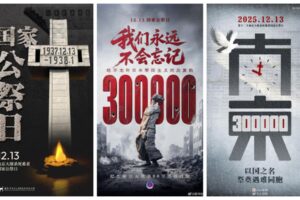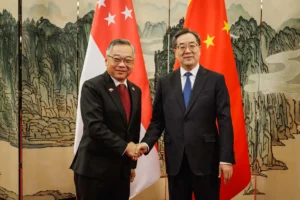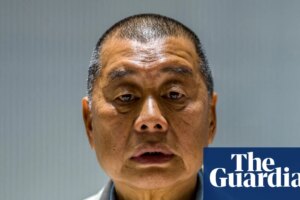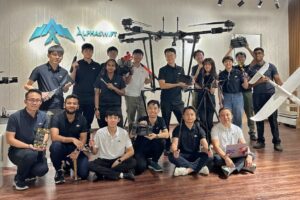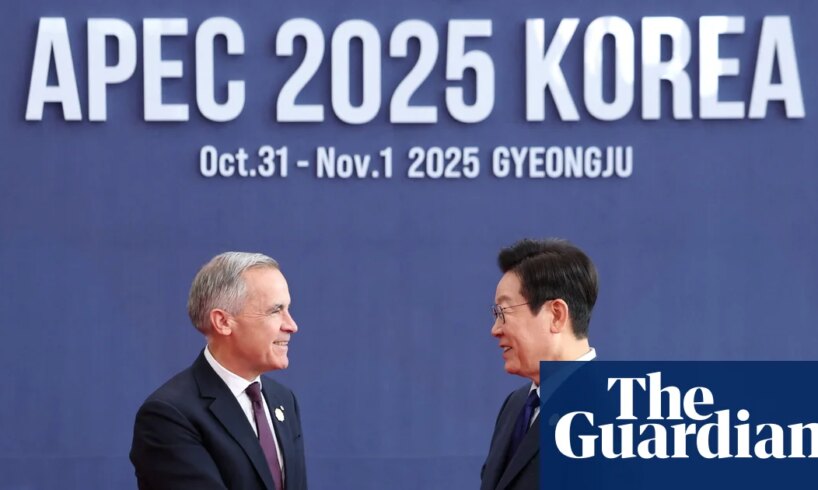
The Canadian prime minister, Mark Carney, has warned that the era of free trade and investment that formed the foundations of the postwar global economy has ended.
In a stark message to Asia-Pacific leaders at the Apec summit in South Korea on Friday, Carney said rules-based open trade no longer worked in a global economy that was undergoing one of its most profound periods of change since the fall of the Berlin Wall in 1989.
“The old world of steady expansion of rules-based liberalised trade and investment, a world on which so much of our nations’ prosperity – very much Canada’s included – is based, that world is gone,” Carney told a business event on the opening day of the summit in the historical town of Gyeongju.
Carney indicated that Canada would edge away from its traditional dependence on trade with the US, saying it aimed to double non-US exports over the next decade.
Later, in the first formal meeting between Canadian and Chinese leaders since 2017, Carney said he looked forward to working more closely with the Chinese leader, Xi Jinping, to “help build a more sustainable, inclusive international system”.
Xi invited Carney to visit China, adding that ties between the two countries had shown signs of recovery after years of tension under Carney’s predecessor, Justin Trudeau. “Recently, with the joint efforts of both sides, China-Canada relations have shown a recovery toward a trend of positive development,” Xi told Carney.
“China is willing to work with Canada to bring China-Canada relations back to the right track.”
Carney responded: “I also welcome the invitation to come to China to further the dialogue and I very much look forward to doing so,” adding that he looked forward to “constructive and pragmatic dialogue”.
Donald Trump and Xi Jinping before a bilateral meeting in Busan, South Korea. Photograph: Andrew Harnik/Getty Images
His declaration of the demise of “rules-based” free trade came days after Xi and Donald Trump backed away from an all-out trade war – a truce that was greeted with relief by world leaders, but which was also a reminder of deep-seated differences between the leaders of the world’s two biggest economies.
Carney said earlier this month that Canada would resume trade negotiations with the US only “when the Americans are ready” – an apparent reference to Trump’s decision to immediately end “all trade negotiations” over a television advertisement opposing US tariffs that quoted the former US president Ronald Reagan.
The advert, which was paid for by the government of the Canadian province of Ontario, uses excerpts of a 1987 speech in which Reagan said that “trade barriers hurt every American worker”.
Earlier on Friday, Xi mounted a robust defence of free trade, according to the Chinese foreign ministry, in an apparent swipe at Trump’s “America first” protectionism.
“The more turbulent the times, the more we must work together,” Xi said during a closed-door session. “The world is undergoing a period of rapid change, with the international situation becoming increasingly complex and volatile.”
The two-day summit has been eclipsed by Trump’s crucial talks with Xi on Thursday, when they agreed to withdraw their most extreme tariff and export control threats.
Supply chains and free trade continued to dominate discussions among Apec’s 21 members at the summit, with the US represented by the US treasury secretary, Scott Bessent.
Japan’s prime minister, Sanae Takaichi, attending a session in Gyeongju. Photograph: Yonhap/Apec 2025 Korea/AFP/Getty Images
While Trump chose to skip the talks after reaching a deal on rare earth minerals, soya beans and tariffs with Xi, the Chinese leader was positioning himself as the champion of free and open trade. Aside from Carney, he met Japan’s new prime minister, Sanae Takaichi, and is expected to hold talks with the South Korean president, Lee Jae-myung, on Saturday.
Carney is reportedly aiming to restart broad engagement with China – Canada’s second-biggest trading parter – after years of tension and amid a rapid deterioration of Canada’s ties with the US since Trump won his second term in the White House.
Under Trudeau, the Chinese government detained and executed Canadian nationals and interfered in federal elections, according to Canada’s security authorities.
US officials defended Trump’s departure from the summit straight after his talks with Xi – a decision critics say demonstrated his lack of engagement with Apec countries, which together account for 40% of the world’s population and 50% of trade.
When asked why Trump had left on the eve of the leaders’ summit, Casey Mace, a senior administration official, said the US’s contribution in Gyeongju had been “very strong and robust”.
Washington’s engagement in the region was in evidence in Malaysia, where the US defence secretary, Pete Hegseth, met his counterparts from China and India on Friday at the start of an Asean defence summit.
In a post on X, Hegseth said he had told his Chinese counterpart, Dong Jun, that the US would “stoutly defend its interests” and maintain the balance of power in the Indo-Pacific. He also voiced concern about Chinese military activities in disputed areas of the South China Sea and around Taiwan.
The US and India signed a 10-year defence cooperation framework that Hegseth hailed as “a cornerstone for regional stability and deterrence”.
Xi’s first encounter with Takaichi was potentially the most awkward of his round of bilateral meetings. Japan’s first female prime minister is hawkish on China’s military buildup in the region and has targeted wealthy Chinese people in calling for a crackdown on foreigners who buy up property and other assets in Japan.
Takaichi and Xi said they wanted to build a “strategic and mutually beneficial relationship”, despite longstanding differences over historical and territorial issues.
“Japan and China share responsibilities for the peace and prosperity of the region,” Takaichi said. “While there are various pending issues and challenges between our countries, I hope we can reduce those and increase dialogue and cooperation.”
Xi reportedly said he wanted to keep communicating with Takaichi to keep bilateral ties “on the right track”.
Takaichi is a historical revisionist who has sought to play down Japanese atrocities in occupied China and other parts of Asia before and during the second world war, and has made pilgrimages to Yasukuni, a shrine in Tokyo that honours Japan’s war dead, including class-A war criminals.
Takaichi, who skipped a visit to Yasukuni shortly before she became prime minister, told parliament last week that Japan would increase defence spending to 2% of GDP by the end of March, two years earlier than planned.
Tokyo and Beijing have yet to resolve several sources of bilateral friction, including Chinese import restrictions on Japanese seafood and agricultural products – imposed after Japan started releasing treated wastewater from the damaged Fukushima Daiichi nuclear power plant in August 2023 – and a long-running territorial dispute over the Senkaku/Diaoyu islands in the East China Sea.
